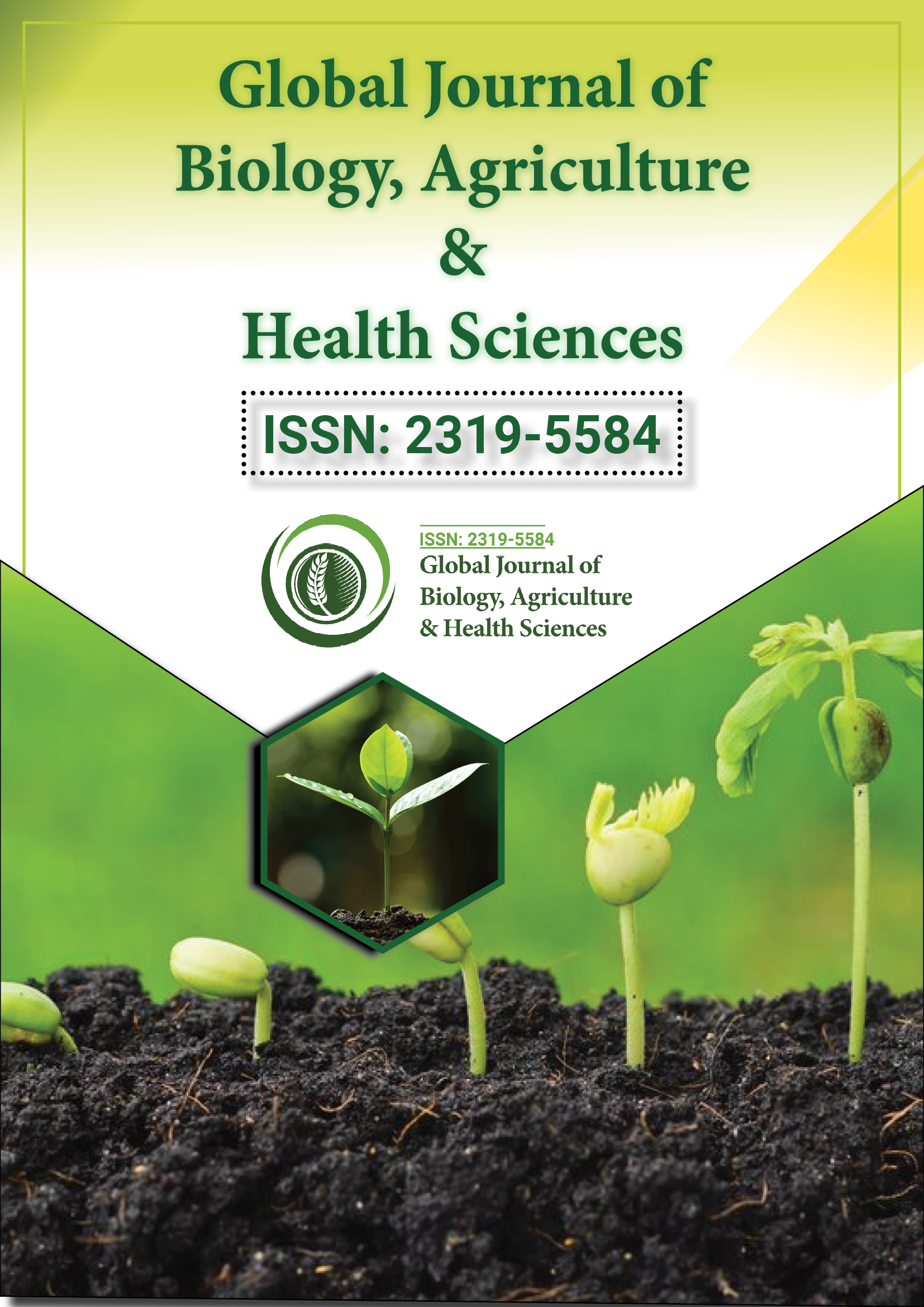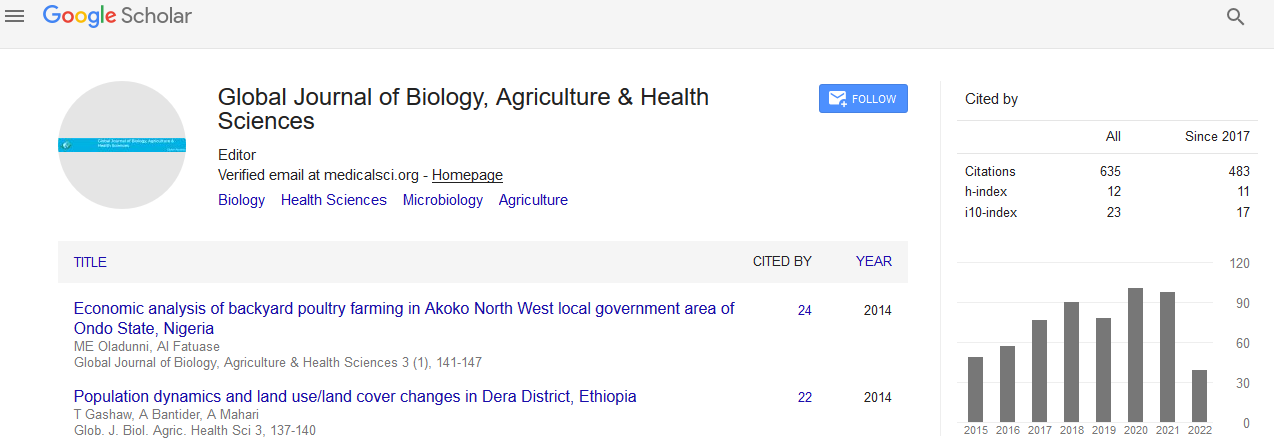Indexed In
- Euro Pub
- Google Scholar
Useful Links
Share This Page
Journal Flyer

Open Access Journals
- Agri and Aquaculture
- Biochemistry
- Bioinformatics & Systems Biology
- Business & Management
- Chemistry
- Clinical Sciences
- Engineering
- Food & Nutrition
- General Science
- Genetics & Molecular Biology
- Immunology & Microbiology
- Medical Sciences
- Neuroscience & Psychology
- Nursing & Health Care
- Pharmaceutical Sciences
Short Communication - (2024) Volume 13, Issue 1
Climate Change-Induced Water Scarcity in Ethiopia and Kenya
Yuan Lu*Received: 27-Feb-2024, Manuscript No. GJBAHS-24-25251; Editor assigned: 29-Feb-2024, Pre QC No. GJBAHS-24-25251 (PQ); Reviewed: 14-Mar-2024, QC No. GJBAHS-24-25251 (QC); Revised: 21-Mar-2024, Manuscript No. GJBAHS-24-25251 (R); Published: 28-Mar-2024, DOI: 10.35248/2319-5584.24.13.217
Introduction
Climate change, like in many regions worldwide, constitutes a significant factor influencing water availability in Ethiopia and Kenya. Water scarcity arises from diminished precipitation coupled with rapid and persistent temperature increases. This Short Communication aims to explore the vulnerability of communities in Ethiopia and Kenya to climate change-induced water scarcity and assess adaptation strategies. This paper identifies planned and spontaneous adaptation measures to water scarcity in both countries. Climate change impacts, primarily driven by arid conditions and uncertainty, manifest in rising temperatures and erratic rainfall patterns, with future projections indicating exacerbation. While the effects of climate change vary spatially and temporally, alterations in water resource quantity and quality are notable in Ethiopia and Kenya. Factors such as population density, urbanization, and industrial growth further compound water scarcity challenges. Virtually every sector, including agriculture, health, and trade, experiences repercussions, such as unpredictable rainfall affecting farming, waterborne diseases during floods impacting public health, and infrastructure damage hindering commerce. Vulnerability levels vary across nations, regions, and demographics, with women and children often disproportionately affected and in need of adaptation and mitigation efforts. Strengthening resilience against climate change impacts on water resources in Ethiopia and Kenya demands a comprehensive approach integrating systems thinking and risk management strategies. Timely action, supported by science, technology, innovative solutions, robust water governance frameworks, and collaboration across public, private, and international sectors, is imperative for averting water shortages.
Description
Habib [1], assert that climate change is a primary physical driver of potential water scarcity in Africa, exacerbated by human induced factors such as population growth. These physical drivers encompass altered rainfall patterns, decreased precipitation and runoff, and heightened evapotranspiration rates. However, Osakabe, et al., [2-4], highlight a broader perspective, indicating that water scarcity in Africa is influenced not only by physical water resources but also by a myriad of societal factors including governance, institutions, gender equality, poverty, security, education, and health. Moreover, climate change impacts not just the hydrological cycle but also these socio-economic drivers of water scarcity [5,6]. Human responses to water scarcity can lead to cumulative and cascading consequences on the resilience of water resources in both the present and future [7].
This paper aimed to analyze the vulnerability of communities to climate change-induced water scarcity in Ethiopia and Kenya. Grey literature, such as unpublished papers and conference proceedings, was also included. Searches utilized keywords such as "climate change," "vulnerability of communities to climate change," "adaptation," as well as phrases like "climate change induced water scarcity," "adaptation strategies to climate change," and "climate change impacts in Ethiopia and Kenya" [8].
This paper aims to explore the susceptibility of communities in Ethiopia and Kenya to water scarcity induced by climate change, recognizing the significant environmental, social, and economic challenges posed by this global phenomenon. Understanding a community's vulnerability is important for comprehending the causes, effects, and necessary response mechanisms to address climate change impacts.
The empirical evidence highlights that climate change arises from a complex interplay of natural forces and human activities, detrimentally affecting water resources. Supporting vulnerable communities most affected by climate change requires developing strategies to diversify economic prospects, foster entrepreneurial initiatives with resilience mechanisms, and implement climate change adaptation measures. Moving beyond command-andcontrol policies, market-based strategies such as carbon tradingand exchange should be prioritized to incentivize local community participation in tackling climate change issues [9,10].
Conclusion
Ethiopia and Kenya are expected to face significant impacts on water resources due to climate change, compounded by rapid population growth, unequal resource access, food insecurity, weak healthcare systems, and poverty. This heightened vulnerability underscores the urgent need for action. In many instances, climate change affects water supplies in both countries, necessitating long journeys for water retrieval, particularly for women and children. Despite progress, access to improved sanitation remains limited for over two-thirds of the population in Ethiopia and Kenya. While efforts have been made to reduce mortality rates, continued focus on improving access to clean water and sanitation is imperative for addressing waterborne diseases and lowering child mortality rates further. However, the impacts of climate change on water resources are anticipated to exacerbate as Ethiopia and Kenya lag behind in scientific advancement, technological sophistication, and innovation.
References
- Habib M. Effect of foliar application of Zn and Fe on wheat yield and quality. Afr J Biotechnol. 2009;8(24):6795-6798.
- Osakabe Y, Osakabe K, Shinozaki K, Tran LS. Response of plants to water stress. Front Plant Sci. 2014;5:86.
- Alloway BJ. Soil factors associated with zinc deficiency in crops and humans. Environ Geochem Health. 2009;31:537-548.
[Crossref] [Google Scholar] [PubMed]
- Singh MV. Micronutrients deficiencies in crops and soils in India. Micro Def Glob Crop Prod. 2008.
- Ethiopian agricultural transformation agency. EthioSIS. 2015.
- Asefa F, Mohammed M, Debela A. Effects of different rates of NPK and blended fertilizers on nutrient uptake and use efficiency of Teff (Eragrostis Tef (Zuccagni) Trotter) in Dedessa district, Southwestern Ethiopia. J Biol Agr Heal. 2014;4(25).
- Patel KP, Singh MV. Scenario of micro-and secondary-nutrients deficiencies and their management in soils and crops of arid and semi-arid regions of Gujarat. eScholarship. 2009.
- Lucas RE, Knezek BD. Climate and soil conditions promoting micronutrient deficiencies in plants. Soil Sci Soc Ame. 1972:265-288.
- Vaughan C, Dessai S. Climate services for society: Origins, institutional arrangements, and design elements for an evaluation framework. WIREs Clim Change. 2014;5:587-603.
[Crossref] [Google Scholar] [PubMed]
- Visscher K, Stegmaier P, Damm A, Hamaker-Taylor R, Harjanne A, Giordano R. Matching supply and demand: A typology of climate services. Clim Serv. 2020;17:100-136.
Citation: Lu S (2024) Control the Plant-Microbe Interactions for Sustainable Agriculture. Glob J Agric Health Sci. 13:217.
Copyright: © 2024 Lu S. This is an open-access article distributed under the terms of the Creative Commons Attribution License, which permits unrestricted use, distribution, and reproduction in any medium, provided the original author and source are credited.

